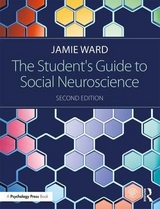
The Student's Guide to Social Neuroscience
Seiten
2011
Psychology Press Ltd (Verlag)
978-1-84872-005-3 (ISBN)
Psychology Press Ltd (Verlag)
978-1-84872-005-3 (ISBN)
- Titel erscheint in neuer Auflage
- Artikel merken
Zu diesem Artikel existiert eine Nachauflage
Shortlisted for the British Psychological Society Book Award 2013!
Social neuroscience is an expanding field which, by investigating the neural mechanisms that inform our behavior, explains our ability to recognize, understand, and interact with others. Concepts such as trust, revenge, empathy, prejudice, and love are now being explored and unraveled by the methods of neuroscience.
Many researchers believe that evolutionary expansion of the primate and human brain was driven by the need to deal with social complexity, not only to understand and outwit our peers, but to take advantage of the benefits of cooperative living. But what kind of brain-based mechanisms did we end up with? Special routines for dealing with social problems, or more general solutions that can be used for non-social cognition too? How are we able to sacrifice our own self-interests to respond to the needs of others? How do cultural differences in the organization of society shape individual minds (and brains), and does the brain provide constraints on the possible range of cultural permutations? The Student’s Guide to Social Neuroscience explores and explains these big issues, using accessible examples from contemporary research.
The first book of its kind, this engaging and cutting-edge text is an ideal introduction to the methods and concepts of social neuroscience for undergraduate and postgraduate students in fields such as psychology and neuroscience. Each chapter is richly illustrated in attractive full-color with figures, boxes, and `real-world’ implications of research. Several pedagogical features help students engage with the material, including essay questions, summary and key points, and further reading. This book is accompanied by substantial online resources that are available to qualifying adopters.
Social neuroscience is an expanding field which, by investigating the neural mechanisms that inform our behavior, explains our ability to recognize, understand, and interact with others. Concepts such as trust, revenge, empathy, prejudice, and love are now being explored and unraveled by the methods of neuroscience.
Many researchers believe that evolutionary expansion of the primate and human brain was driven by the need to deal with social complexity, not only to understand and outwit our peers, but to take advantage of the benefits of cooperative living. But what kind of brain-based mechanisms did we end up with? Special routines for dealing with social problems, or more general solutions that can be used for non-social cognition too? How are we able to sacrifice our own self-interests to respond to the needs of others? How do cultural differences in the organization of society shape individual minds (and brains), and does the brain provide constraints on the possible range of cultural permutations? The Student’s Guide to Social Neuroscience explores and explains these big issues, using accessible examples from contemporary research.
The first book of its kind, this engaging and cutting-edge text is an ideal introduction to the methods and concepts of social neuroscience for undergraduate and postgraduate students in fields such as psychology and neuroscience. Each chapter is richly illustrated in attractive full-color with figures, boxes, and `real-world’ implications of research. Several pedagogical features help students engage with the material, including essay questions, summary and key points, and further reading. This book is accompanied by substantial online resources that are available to qualifying adopters.
Dr Jamie Ward is an Associate Professor at the University of Sussex, UK. He has published over 60 scientific papers and several books including The Student’s Guide to Cognitive Neuroscience (now in its second edition) and The Frog who Croaked Blue: Synesthesia and the Mixing of the Senses. He is the editor-in-chief of Cognitive Neuroscience, a journal from Psychology Press.
1. Introduction to Social Neuroscience 2. The Methods of Social Neuroscience 3. Evolutionary Origins of Social Intelligence and Culture 4. Emotion and Motivation 5. Reading Faces and Bodies 6. Understanding Others 7. Interacting with Others 8. Relationships 9. Groups and Identity 10. Morality and Anti-Social Behaviour 11. Developmental Social Neuroscience
| Erscheint lt. Verlag | 14.10.2011 |
|---|---|
| Verlagsort | Hove |
| Sprache | englisch |
| Maße | 189 x 246 mm |
| Gewicht | 748 g |
| Themenwelt | Geisteswissenschaften ► Psychologie ► Allgemeine Psychologie |
| Geisteswissenschaften ► Psychologie ► Sozialpsychologie | |
| Geisteswissenschaften ► Psychologie ► Verhaltenstherapie | |
| Naturwissenschaften ► Biologie ► Humanbiologie | |
| Naturwissenschaften ► Biologie ► Zoologie | |
| ISBN-10 | 1-84872-005-X / 184872005X |
| ISBN-13 | 978-1-84872-005-3 / 9781848720053 |
| Zustand | Neuware |
| Informationen gemäß Produktsicherheitsverordnung (GPSR) | |
| Haben Sie eine Frage zum Produkt? |
Mehr entdecken
aus dem Bereich
aus dem Bereich
Techniken der Verhaltenstherapie
Buch (2024)
Julius Beltz GmbH & Co. KG (Verlag)
35,00 €



